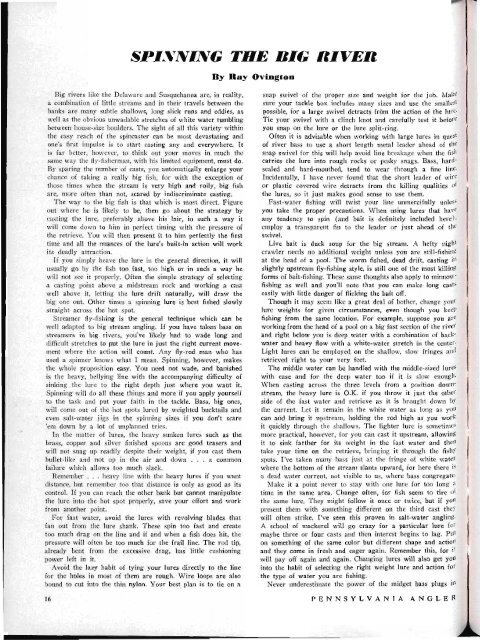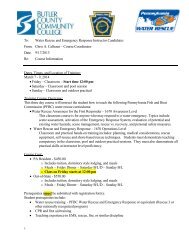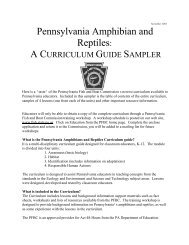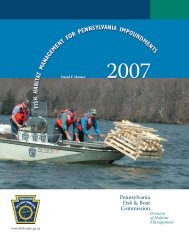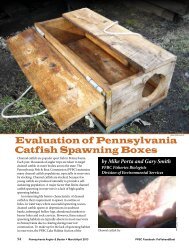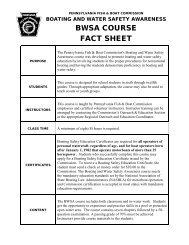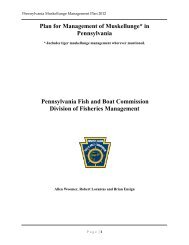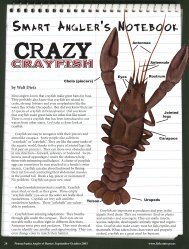june 1963 boating issue - Pennsylvania Fish and Boat Commission
june 1963 boating issue - Pennsylvania Fish and Boat Commission
june 1963 boating issue - Pennsylvania Fish and Boat Commission
You also want an ePaper? Increase the reach of your titles
YUMPU automatically turns print PDFs into web optimized ePapers that Google loves.
SPINNING THE BIG RIVER<br />
Big rivers like the Delaware <strong>and</strong> Susquehanna are, in reality,<br />
a combination of little streams <strong>and</strong> in their travels between the<br />
banks are many subtle shallows, long slick runs <strong>and</strong> eddies, as<br />
well as the obvious unwadable stretches of white water tumbling<br />
between house-size boulders. The sight of all this variety within<br />
the easy reach of the spincaster can be most devastating <strong>and</strong><br />
one's first impulse is to start casting any <strong>and</strong> everywhere. It<br />
is far better, however, to think out your moves in much the<br />
same way the fly-fisherman, with his limited equipment, must do.<br />
By sparing the number of casts, you automatically enlarge your<br />
chance of taking a really big fish, for with the exception of<br />
those times when the stream is very high <strong>and</strong> roily, big fish<br />
are, more often than not, scared by indiscriminate casting.<br />
The way to the big fish is that which is most direct. Figure<br />
out where he is likely to be, then go about the strategy by<br />
casting the lure, preferably above his lair, in such a way it<br />
will come down to him in perfect timing with the pressure of<br />
the retrieve. You will then present it to him perfectly the first<br />
time <strong>and</strong> all the nuances of the lure's built-in action will work<br />
its deadly attraction.<br />
If you simply heave the lure in the general direction, it will<br />
usually go by the fish too fast, too high or in such a way he<br />
will not see it properly. Often the simple strategy of selecting<br />
a casting point above a midstream rock <strong>and</strong> working a cast<br />
well above it, letting the lure drift naturally, will draw the<br />
big one out. Other times a spinning lure is best fished slowly<br />
straight across the hot spot.<br />
Streamer fly-fishing is the general technique which can be<br />
well adapted to big stream angling. If you have taken bass on<br />
streamers in big rivers, you've likely had to wade long <strong>and</strong><br />
difficult stretches to put the lure in just the right current movement<br />
where the action will count. Any fly-rod man who has<br />
used a spinner knows what I mean. Spinning, however, makes<br />
the whole proposition easy. You need not wade, <strong>and</strong> banished<br />
is the heavy, bellying line with the accompanying difficulty of<br />
sinking the lure to the right depth just where you want it.<br />
Spinning will do all these things <strong>and</strong> more if you apply yourself<br />
to the task <strong>and</strong> put your faith in the tackle. Bass, big ones,<br />
will come out of the hot spots lured by weighted bucktails <strong>and</strong><br />
even salt-water jigs in the spinning sizes if you don't scare<br />
'em down by a lot of unplanned tries.<br />
In the matter of lures, the heavy sunken lures such as the<br />
brass, copper <strong>and</strong> silver finished spoons are good teasers <strong>and</strong><br />
will not snag up readily despite their weight, if you cast them<br />
bullet-like <strong>and</strong> not up in the air <strong>and</strong> down ... a common<br />
failure which allows too much slack.<br />
Remember . . . heavy line with the heavy lures if you want<br />
distance, but remember too that distance is only as good as its<br />
control. If you can reach the other bank but cannot manipulate<br />
the lure into the hot spot properly, save your effort <strong>and</strong> work<br />
from another point.<br />
For fast water, avoid the lures with revolving blades that<br />
fan out from the lure shank. These spin too fast <strong>and</strong> create<br />
too much drag on the line <strong>and</strong> if <strong>and</strong> when a fish does hit, the<br />
pressure will often be too much for the frail line. The rod tip,<br />
already bent from the excessive drag, has little cushioning<br />
power left in it.<br />
Avoid the lazy habit of tying your lures directly to the line<br />
for the holes in most of them are rough. Wire loops are also<br />
bound to cut into the thin nylon. Your best plan is to tie on a<br />
By Ray Ovington<br />
snap swivel of the proper size <strong>and</strong> weight for the job. Make<br />
sure your tackle box includes many sizes <strong>and</strong> use the smallest<br />
possible, for a large swivel detracts from the action of the lure-<br />
Tie your swivel with a clinch knot <strong>and</strong> carefully test it before<br />
you snap on the lure or the lure split-ring.<br />
Often it is advisable when working with large lures in quest<br />
of river bass to use a short length metal leader ahead of th e<br />
snap swivel for this will help avoid line breakage when the fis' 1<br />
carries the lure into rough rocks or pesky snags. Bass, hardscaled<br />
<strong>and</strong> hard-mouthed, tend to wear through a fine line-<br />
Incidentally, I have never found that the short leader of wire<br />
or plastic covered wire detracts from the killing qualities 0»<br />
the lures, so it just makes good sense to use them.<br />
Fast-water fishing will twist your line unmercifully unless<br />
you take the proper precautions. When using lures that have<br />
any tendency to spin (<strong>and</strong> bait is definitely included here)employ<br />
a transparent fin to the leader or just ahead of the<br />
swivel.<br />
Live bait is duck soup for the big stream. A hefty nigh'<br />
crawler needs no additional weight unless you are still-fishing<br />
at the head of a pool. The worm fished, dead drift, casting i' 1<br />
slightly upstream fly-fishing style, is still one of the most killing<br />
forms of bait-fishing. These same thoughts also apply to minno\Vfishing<br />
as well <strong>and</strong> you'll note that you can make long casts<br />
easily with little danger of flicking the bait off.<br />
Though it may seem like a great deal of bother, change you''<br />
lure weights for given circumstances, even though you keel'<br />
fishing from the same location. For example, suppose you are<br />
working from the head of a pool on a big fast section of the river<br />
<strong>and</strong> right below you is deep water with a combination of backwater<br />
<strong>and</strong> heavy flow with a white-water stretch in the center-<br />
Light lures can be employed on the shallow, slow fringes an''<br />
retrieved right to your very feet.<br />
The middle water can be h<strong>and</strong>led with the middle-sized lures<br />
with ease <strong>and</strong> for the deep water too if it is slow enough-<br />
When casting across the three levels from a position downstream,<br />
the heavy lure is O.K. if you throw it just the other<br />
side of the fast water <strong>and</strong> retrieve as it is brought down by<br />
the current. Let it remain in the white water as long as you<br />
can <strong>and</strong> bring it upstream, holding the rod high as you work<br />
it quickly through the shallows. The lighter lure is sometime^<br />
more practical, however, for you can cast it upstream, allowing<br />
it to sink farther for its weight in the fast water <strong>and</strong> then<br />
take your time on the retrieve, bringing" it through the fish)'<br />
spots. I've taken many bass just at the fringe of white water<br />
where the bottom of the stream slants upward, for here there is<br />
a dead water current, not visible to us, where bass congregate-<br />
Make it a point never to stay with one lure for too long < l<br />
time in the same area. Change often, for fish seem to tire of<br />
the same lure. They might follow it once or twice, but if yov'<br />
present them with something different on the third cast the)'<br />
will often strike. I've seen this proven in salt-water angling-<br />
A school of mackerel will go crazy for a particular lure fo'-'<br />
maybe three or four casts <strong>and</strong> then interest begins to lag. Put<br />
on something of the same color but different shape <strong>and</strong> actid 1<br />
<strong>and</strong> they come in fresh <strong>and</strong> eager again. Remember this, for i'<br />
will pay off again <strong>and</strong> again. Changing lures will also get yotf<br />
into the habit of selecting the right weight lure <strong>and</strong> action for<br />
the type of water you are fishing.<br />
Never underestimate the power of the midget bass plugs i' 1<br />
16 P E N N S Y L V A N I A ANGLEU


